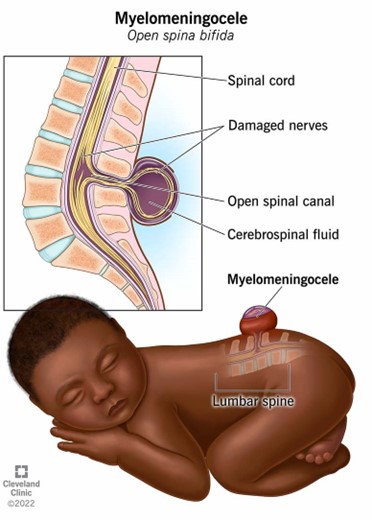A nurse is orienting a newly licensed nurse in the care of an infant who has myelomeningocele.
Which of the following actions by the new nurse indicates the teaching has been effective?
Takes an axillary temperature.
Places the infant in a side-lying position.
Maintains a dry dressing over the sac.
Performs range of motion on the infant's hips.
The Correct Answer is A
A. Infants with spina bifida, including those with myelomeningocele, have an increased risk of rectal anomalies, so avoiding rectal temperatures is essential. The correct and safe method of temperature measurement for these infants is typically axillary.
B. Placing the infant in a side-lying position is not recommended for a child with myelomeningocele. The preferred position is prone to avoid pressure on the sac and reduce the risk of rupture and infection.
C. Maintains a dry dressing over the sac: While the sac should be kept covered, it is typically kept moist with sterile saline-soaked gauze to prevent it from drying out and to minimize the risk of infection.
D. Performs range of motion on the infant's hips: Range of motion exercises might be indicated later on, but initially, the focus is on protecting the sac and preventing complications.

Nursing Test Bank
Naxlex Comprehensive Predictor Exams
Related Questions
Correct Answer is A
Explanation
Head lice are spread most commonly by direct head-to-head (hair-to-hair) contact.
However, much less frequently they are spread by sharing clothing or belongings onto which lice have crawled or nits attached to shed hairs may have fallen.
Choice B is not correct because lice cannot jump from one child to another. Choice C is not correct because live lice survive less than 1-2 days if they fall off a
person and cannot feed.
Choice D is not correct because washing your child’s hair daily will not prevent lice.
Correct Answer is D
Explanation
Treatment of eczema may start with regular moisturizing and other self-care habits.
If these don’t help, a healthcare provider might suggest medicated creams that control itching and help repair skin.
Choice A is not correct because woolen clothes can irritate the skin and worsen
eczema.
Choice B is not correct because fabric softeners can irritate the skin and worsen
eczema.
Choice C is not correct because bubble baths can dry out the skin and worsen eczema.

Whether you are a student looking to ace your exams or a practicing nurse seeking to enhance your expertise , our nursing education contents will empower you with the confidence and competence to make a difference in the lives of patients and become a respected leader in the healthcare field.
Visit Naxlex, invest in your future and unlock endless possibilities with our unparalleled nursing education contents today
Report Wrong Answer on the Current Question
Do you disagree with the answer? If yes, what is your expected answer? Explain.
Kindly be descriptive with the issue you are facing.
